Competitive Analysis of Tesco: Market Share and Strategy Overview
VerifiedAdded on 2020/10/22
|10
|2554
|228
Report
AI Summary
This report provides a comprehensive analysis of Tesco, a leading global retail company. It begins with an introduction to Tesco's operations, market share, and key issues. The main body of the report delves into Tesco's competitive environment using Porter's Five Forces model, examining the bargaining power of buyers and suppliers, threats of substitutes and new entrants, and the intensity of rivalry among competitors. Furthermore, the report applies the VRIO framework to assess Tesco's internal resources, evaluating their value, rareness, imitability, and organizational competence. Other aspects such as supply chain management, pricing strategies, brand value, and marketing efforts are also discussed to highlight Tesco's competitive advantages. The conclusion summarizes the findings, emphasizing Tesco's strong market position, effective strategies, and competitive advantages in the retail industry. The report is a valuable resource for students studying business and strategy, providing insights into real-world business practices and competitive dynamics. This document is contributed by a student to be published on the website Desklib, a platform which provides all the necessary AI based study tools for students.

BUSINESS FOUNDATION
Paraphrase This Document
Need a fresh take? Get an instant paraphrase of this document with our AI Paraphraser
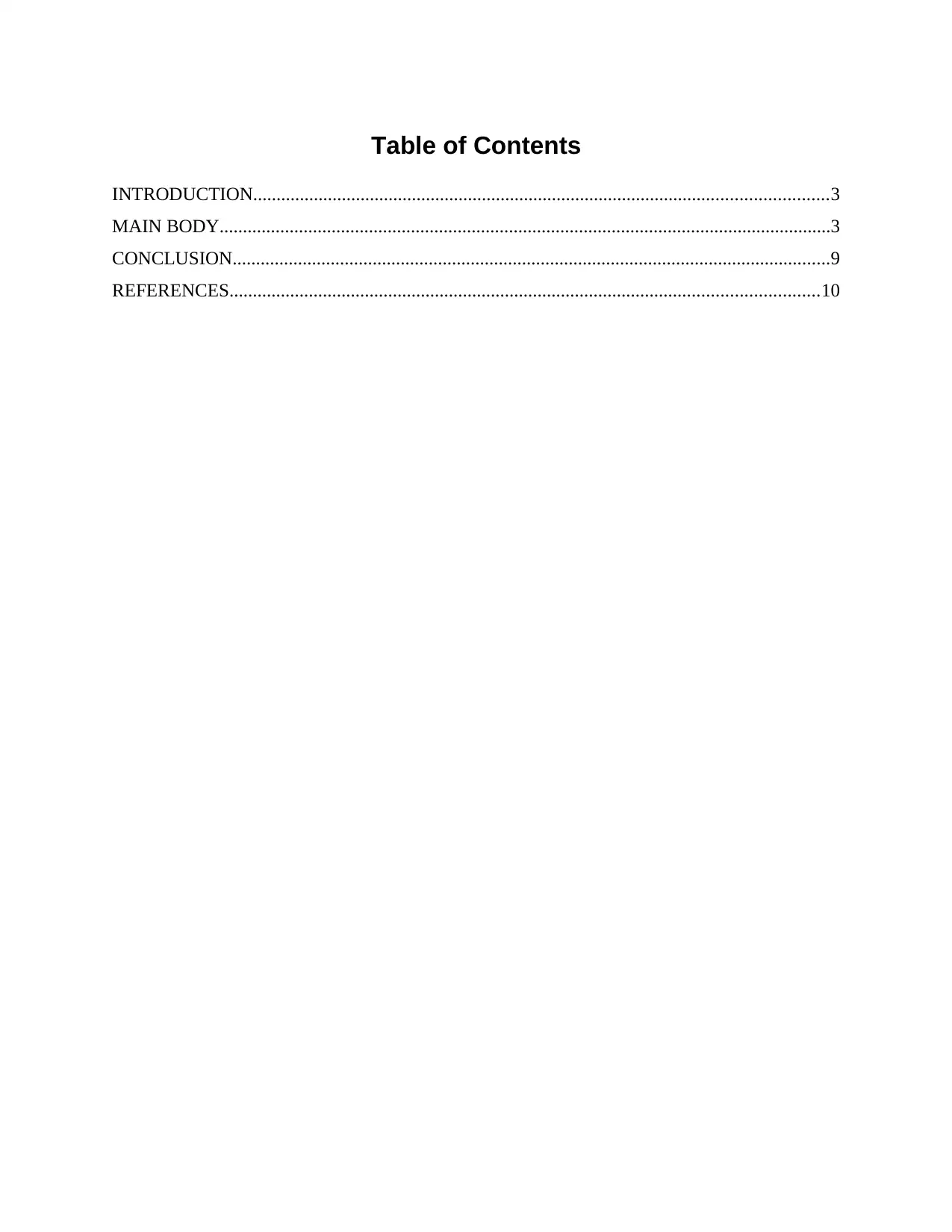
Table of Contents
INTRODUCTION...........................................................................................................................3
MAIN BODY...................................................................................................................................3
CONCLUSION................................................................................................................................9
REFERENCES..............................................................................................................................10
INTRODUCTION...........................................................................................................................3
MAIN BODY...................................................................................................................................3
CONCLUSION................................................................................................................................9
REFERENCES..............................................................................................................................10
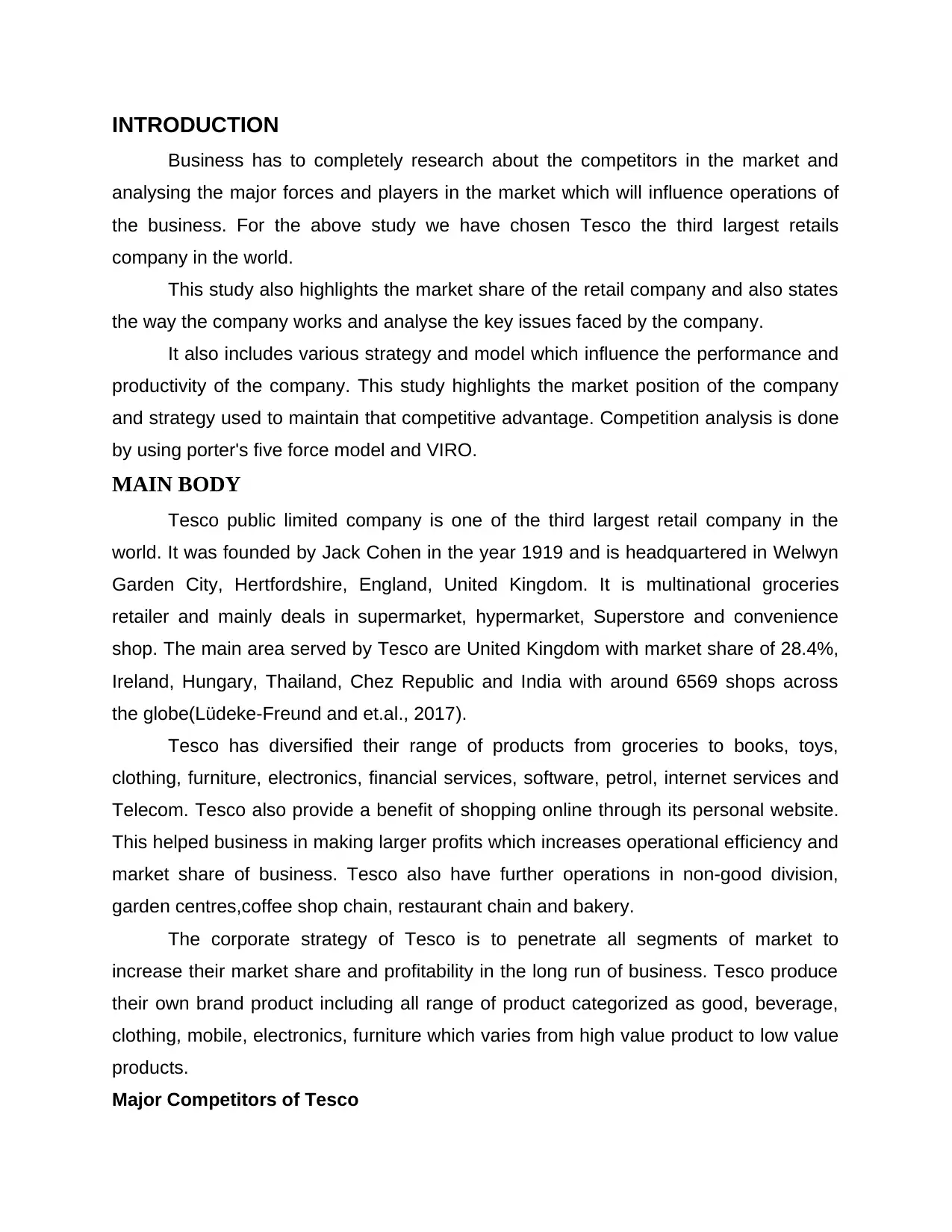
INTRODUCTION
Business has to completely research about the competitors in the market and
analysing the major forces and players in the market which will influence operations of
the business. For the above study we have chosen Tesco the third largest retails
company in the world.
This study also highlights the market share of the retail company and also states
the way the company works and analyse the key issues faced by the company.
It also includes various strategy and model which influence the performance and
productivity of the company. This study highlights the market position of the company
and strategy used to maintain that competitive advantage. Competition analysis is done
by using porter's five force model and VIRO.
MAIN BODY
Tesco public limited company is one of the third largest retail company in the
world. It was founded by Jack Cohen in the year 1919 and is headquartered in Welwyn
Garden City, Hertfordshire, England, United Kingdom. It is multinational groceries
retailer and mainly deals in supermarket, hypermarket, Superstore and convenience
shop. The main area served by Tesco are United Kingdom with market share of 28.4%,
Ireland, Hungary, Thailand, Chez Republic and India with around 6569 shops across
the globe(Lüdeke-Freund and et.al., 2017).
Tesco has diversified their range of products from groceries to books, toys,
clothing, furniture, electronics, financial services, software, petrol, internet services and
Telecom. Tesco also provide a benefit of shopping online through its personal website.
This helped business in making larger profits which increases operational efficiency and
market share of business. Tesco also have further operations in non-good division,
garden centres,coffee shop chain, restaurant chain and bakery.
The corporate strategy of Tesco is to penetrate all segments of market to
increase their market share and profitability in the long run of business. Tesco produce
their own brand product including all range of product categorized as good, beverage,
clothing, mobile, electronics, furniture which varies from high value product to low value
products.
Major Competitors of Tesco
Business has to completely research about the competitors in the market and
analysing the major forces and players in the market which will influence operations of
the business. For the above study we have chosen Tesco the third largest retails
company in the world.
This study also highlights the market share of the retail company and also states
the way the company works and analyse the key issues faced by the company.
It also includes various strategy and model which influence the performance and
productivity of the company. This study highlights the market position of the company
and strategy used to maintain that competitive advantage. Competition analysis is done
by using porter's five force model and VIRO.
MAIN BODY
Tesco public limited company is one of the third largest retail company in the
world. It was founded by Jack Cohen in the year 1919 and is headquartered in Welwyn
Garden City, Hertfordshire, England, United Kingdom. It is multinational groceries
retailer and mainly deals in supermarket, hypermarket, Superstore and convenience
shop. The main area served by Tesco are United Kingdom with market share of 28.4%,
Ireland, Hungary, Thailand, Chez Republic and India with around 6569 shops across
the globe(Lüdeke-Freund and et.al., 2017).
Tesco has diversified their range of products from groceries to books, toys,
clothing, furniture, electronics, financial services, software, petrol, internet services and
Telecom. Tesco also provide a benefit of shopping online through its personal website.
This helped business in making larger profits which increases operational efficiency and
market share of business. Tesco also have further operations in non-good division,
garden centres,coffee shop chain, restaurant chain and bakery.
The corporate strategy of Tesco is to penetrate all segments of market to
increase their market share and profitability in the long run of business. Tesco produce
their own brand product including all range of product categorized as good, beverage,
clothing, mobile, electronics, furniture which varies from high value product to low value
products.
Major Competitors of Tesco
⊘ This is a preview!⊘
Do you want full access?
Subscribe today to unlock all pages.

Trusted by 1+ million students worldwide
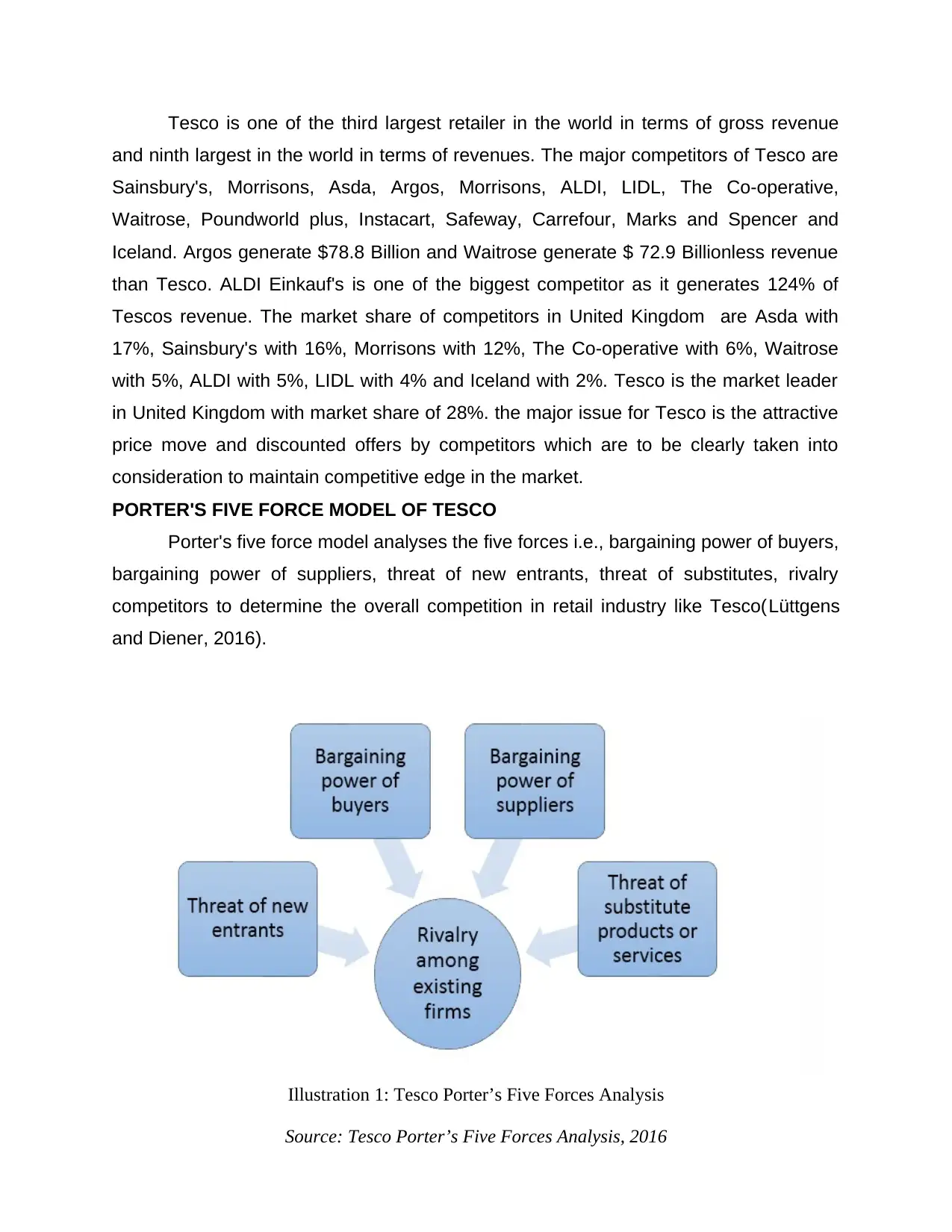
Tesco is one of the third largest retailer in the world in terms of gross revenue
and ninth largest in the world in terms of revenues. The major competitors of Tesco are
Sainsbury's, Morrisons, Asda, Argos, Morrisons, ALDI, LIDL, The Co-operative,
Waitrose, Poundworld plus, Instacart, Safeway, Carrefour, Marks and Spencer and
Iceland. Argos generate $78.8 Billion and Waitrose generate $ 72.9 Billionless revenue
than Tesco. ALDI Einkauf's is one of the biggest competitor as it generates 124% of
Tescos revenue. The market share of competitors in United Kingdom are Asda with
17%, Sainsbury's with 16%, Morrisons with 12%, The Co-operative with 6%, Waitrose
with 5%, ALDI with 5%, LIDL with 4% and Iceland with 2%. Tesco is the market leader
in United Kingdom with market share of 28%. the major issue for Tesco is the attractive
price move and discounted offers by competitors which are to be clearly taken into
consideration to maintain competitive edge in the market.
PORTER'S FIVE FORCE MODEL OF TESCO
Porter's five force model analyses the five forces i.e., bargaining power of buyers,
bargaining power of suppliers, threat of new entrants, threat of substitutes, rivalry
competitors to determine the overall competition in retail industry like Tesco(Lüttgens
and Diener, 2016).
Illustration 1: Tesco Porter’s Five Forces Analysis
Source: Tesco Porter’s Five Forces Analysis, 2016
and ninth largest in the world in terms of revenues. The major competitors of Tesco are
Sainsbury's, Morrisons, Asda, Argos, Morrisons, ALDI, LIDL, The Co-operative,
Waitrose, Poundworld plus, Instacart, Safeway, Carrefour, Marks and Spencer and
Iceland. Argos generate $78.8 Billion and Waitrose generate $ 72.9 Billionless revenue
than Tesco. ALDI Einkauf's is one of the biggest competitor as it generates 124% of
Tescos revenue. The market share of competitors in United Kingdom are Asda with
17%, Sainsbury's with 16%, Morrisons with 12%, The Co-operative with 6%, Waitrose
with 5%, ALDI with 5%, LIDL with 4% and Iceland with 2%. Tesco is the market leader
in United Kingdom with market share of 28%. the major issue for Tesco is the attractive
price move and discounted offers by competitors which are to be clearly taken into
consideration to maintain competitive edge in the market.
PORTER'S FIVE FORCE MODEL OF TESCO
Porter's five force model analyses the five forces i.e., bargaining power of buyers,
bargaining power of suppliers, threat of new entrants, threat of substitutes, rivalry
competitors to determine the overall competition in retail industry like Tesco(Lüttgens
and Diener, 2016).
Illustration 1: Tesco Porter’s Five Forces Analysis
Source: Tesco Porter’s Five Forces Analysis, 2016
Paraphrase This Document
Need a fresh take? Get an instant paraphrase of this document with our AI Paraphraser
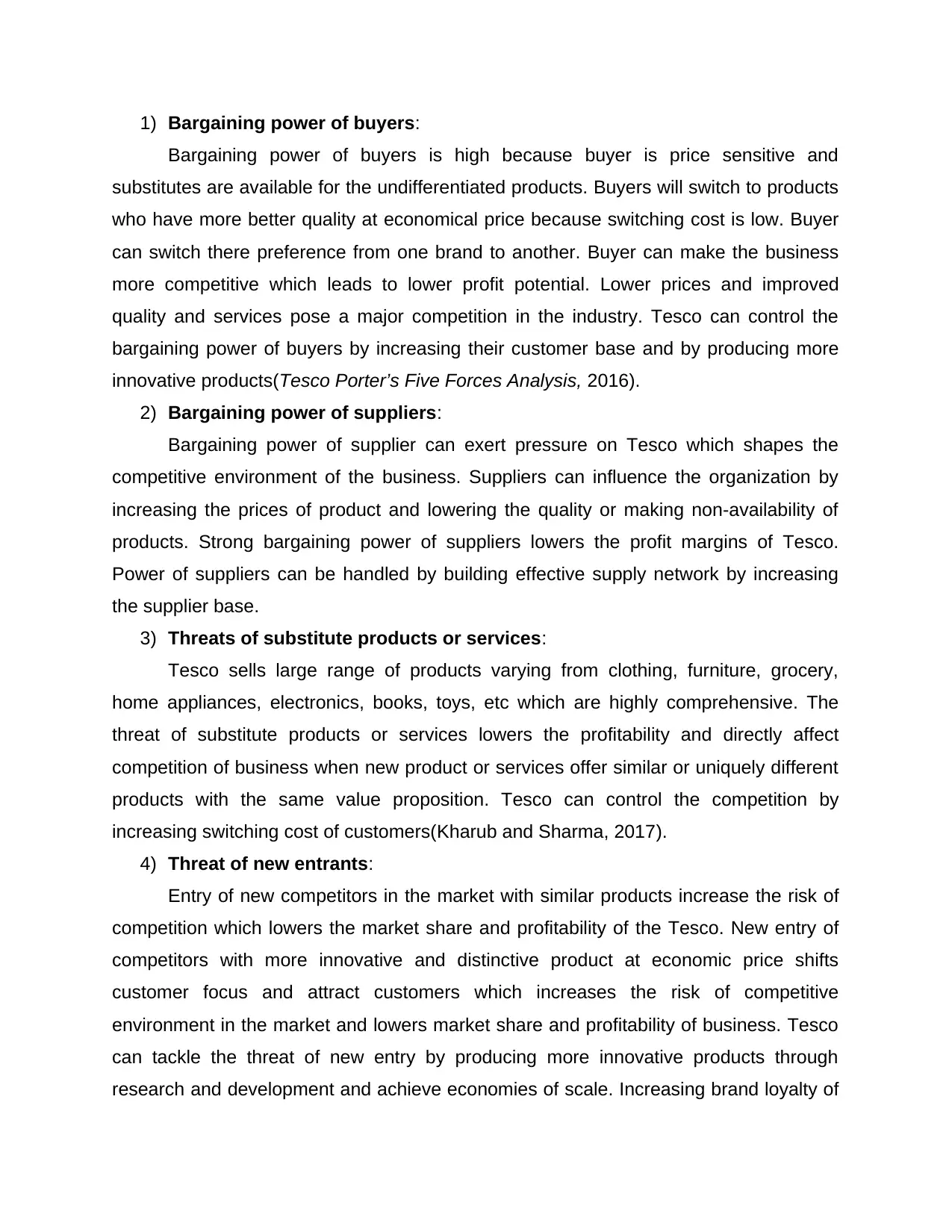
1) Bargaining power of buyers:
Bargaining power of buyers is high because buyer is price sensitive and
substitutes are available for the undifferentiated products. Buyers will switch to products
who have more better quality at economical price because switching cost is low. Buyer
can switch there preference from one brand to another. Buyer can make the business
more competitive which leads to lower profit potential. Lower prices and improved
quality and services pose a major competition in the industry. Tesco can control the
bargaining power of buyers by increasing their customer base and by producing more
innovative products(Tesco Porter’s Five Forces Analysis, 2016).
2) Bargaining power of suppliers:
Bargaining power of supplier can exert pressure on Tesco which shapes the
competitive environment of the business. Suppliers can influence the organization by
increasing the prices of product and lowering the quality or making non-availability of
products. Strong bargaining power of suppliers lowers the profit margins of Tesco.
Power of suppliers can be handled by building effective supply network by increasing
the supplier base.
3) Threats of substitute products or services:
Tesco sells large range of products varying from clothing, furniture, grocery,
home appliances, electronics, books, toys, etc which are highly comprehensive. The
threat of substitute products or services lowers the profitability and directly affect
competition of business when new product or services offer similar or uniquely different
products with the same value proposition. Tesco can control the competition by
increasing switching cost of customers(Kharub and Sharma, 2017).
4) Threat of new entrants:
Entry of new competitors in the market with similar products increase the risk of
competition which lowers the market share and profitability of the Tesco. New entry of
competitors with more innovative and distinctive product at economic price shifts
customer focus and attract customers which increases the risk of competitive
environment in the market and lowers market share and profitability of business. Tesco
can tackle the threat of new entry by producing more innovative products through
research and development and achieve economies of scale. Increasing brand loyalty of
Bargaining power of buyers is high because buyer is price sensitive and
substitutes are available for the undifferentiated products. Buyers will switch to products
who have more better quality at economical price because switching cost is low. Buyer
can switch there preference from one brand to another. Buyer can make the business
more competitive which leads to lower profit potential. Lower prices and improved
quality and services pose a major competition in the industry. Tesco can control the
bargaining power of buyers by increasing their customer base and by producing more
innovative products(Tesco Porter’s Five Forces Analysis, 2016).
2) Bargaining power of suppliers:
Bargaining power of supplier can exert pressure on Tesco which shapes the
competitive environment of the business. Suppliers can influence the organization by
increasing the prices of product and lowering the quality or making non-availability of
products. Strong bargaining power of suppliers lowers the profit margins of Tesco.
Power of suppliers can be handled by building effective supply network by increasing
the supplier base.
3) Threats of substitute products or services:
Tesco sells large range of products varying from clothing, furniture, grocery,
home appliances, electronics, books, toys, etc which are highly comprehensive. The
threat of substitute products or services lowers the profitability and directly affect
competition of business when new product or services offer similar or uniquely different
products with the same value proposition. Tesco can control the competition by
increasing switching cost of customers(Kharub and Sharma, 2017).
4) Threat of new entrants:
Entry of new competitors in the market with similar products increase the risk of
competition which lowers the market share and profitability of the Tesco. New entry of
competitors with more innovative and distinctive product at economic price shifts
customer focus and attract customers which increases the risk of competitive
environment in the market and lowers market share and profitability of business. Tesco
can tackle the threat of new entry by producing more innovative products through
research and development and achieve economies of scale. Increasing brand loyalty of
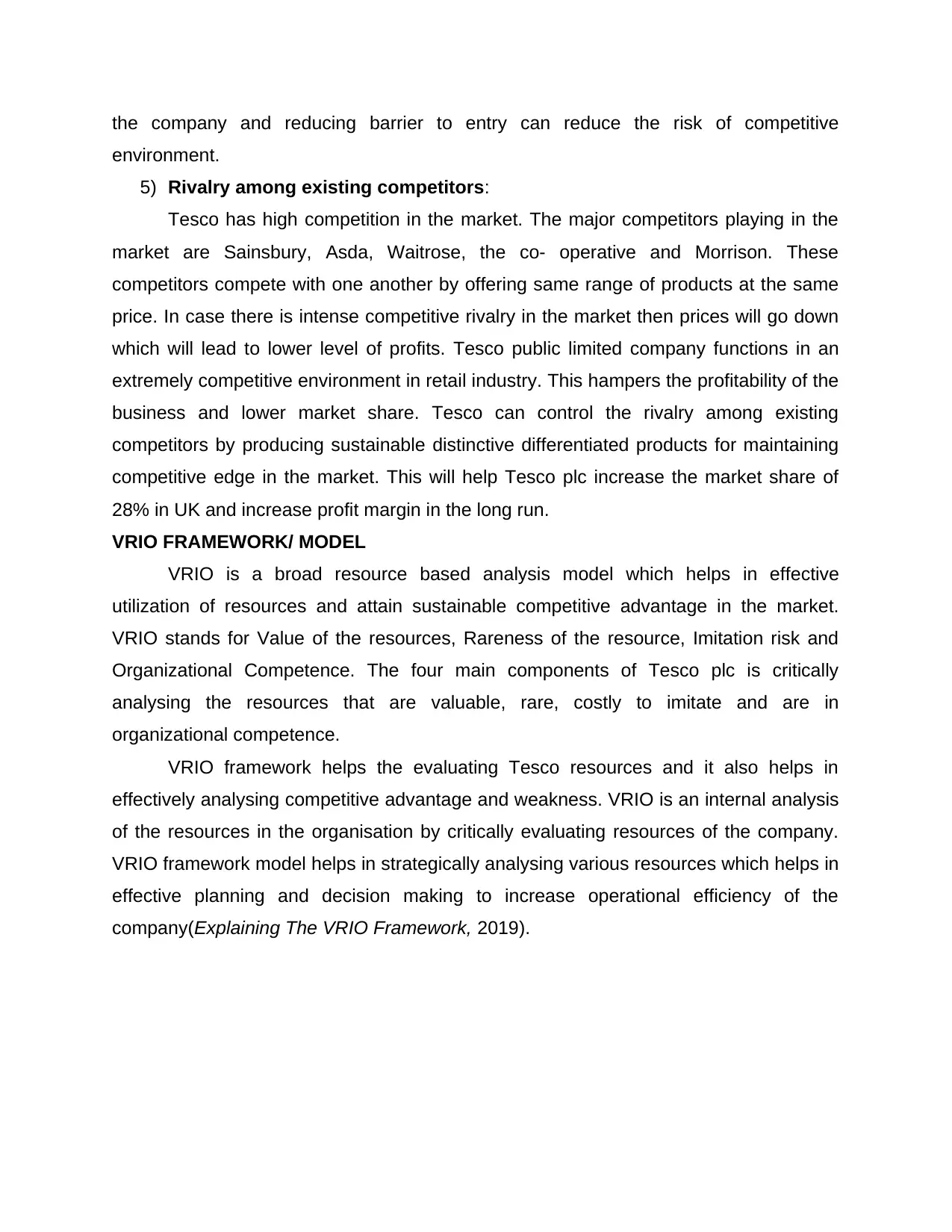
the company and reducing barrier to entry can reduce the risk of competitive
environment.
5) Rivalry among existing competitors:
Tesco has high competition in the market. The major competitors playing in the
market are Sainsbury, Asda, Waitrose, the co- operative and Morrison. These
competitors compete with one another by offering same range of products at the same
price. In case there is intense competitive rivalry in the market then prices will go down
which will lead to lower level of profits. Tesco public limited company functions in an
extremely competitive environment in retail industry. This hampers the profitability of the
business and lower market share. Tesco can control the rivalry among existing
competitors by producing sustainable distinctive differentiated products for maintaining
competitive edge in the market. This will help Tesco plc increase the market share of
28% in UK and increase profit margin in the long run.
VRIO FRAMEWORK/ MODEL
VRIO is a broad resource based analysis model which helps in effective
utilization of resources and attain sustainable competitive advantage in the market.
VRIO stands for Value of the resources, Rareness of the resource, Imitation risk and
Organizational Competence. The four main components of Tesco plc is critically
analysing the resources that are valuable, rare, costly to imitate and are in
organizational competence.
VRIO framework helps the evaluating Tesco resources and it also helps in
effectively analysing competitive advantage and weakness. VRIO is an internal analysis
of the resources in the organisation by critically evaluating resources of the company.
VRIO framework model helps in strategically analysing various resources which helps in
effective planning and decision making to increase operational efficiency of the
company(Explaining The VRIO Framework, 2019).
environment.
5) Rivalry among existing competitors:
Tesco has high competition in the market. The major competitors playing in the
market are Sainsbury, Asda, Waitrose, the co- operative and Morrison. These
competitors compete with one another by offering same range of products at the same
price. In case there is intense competitive rivalry in the market then prices will go down
which will lead to lower level of profits. Tesco public limited company functions in an
extremely competitive environment in retail industry. This hampers the profitability of the
business and lower market share. Tesco can control the rivalry among existing
competitors by producing sustainable distinctive differentiated products for maintaining
competitive edge in the market. This will help Tesco plc increase the market share of
28% in UK and increase profit margin in the long run.
VRIO FRAMEWORK/ MODEL
VRIO is a broad resource based analysis model which helps in effective
utilization of resources and attain sustainable competitive advantage in the market.
VRIO stands for Value of the resources, Rareness of the resource, Imitation risk and
Organizational Competence. The four main components of Tesco plc is critically
analysing the resources that are valuable, rare, costly to imitate and are in
organizational competence.
VRIO framework helps the evaluating Tesco resources and it also helps in
effectively analysing competitive advantage and weakness. VRIO is an internal analysis
of the resources in the organisation by critically evaluating resources of the company.
VRIO framework model helps in strategically analysing various resources which helps in
effective planning and decision making to increase operational efficiency of the
company(Explaining The VRIO Framework, 2019).
⊘ This is a preview!⊘
Do you want full access?
Subscribe today to unlock all pages.

Trusted by 1+ million students worldwide

1.) Value of resources: This helps in analysing whether the particular resources of
the comp[any is is beneficial for Tesco or not. Resources valuable or critical for
maintaining competition in the market includes financial resources, human
resource, marketing expertise and operation management. If the resources are
valuable in one or more regions then such resources are considered valuable for
the development of Tesco. If the resource does not benefit the company in
development then the organization should cut off on using such resources and
allocate the money in those resources which are beneficial for the growth of
Tesco plc(Kashaev, 2018).
2.) Rarity of resources: If the resources used by Tesco is rare then it is the biggest
strength of the company. This will give Tesco competitive advantage by giving
tough time to competitors to over power the company. Tesco public limited
Illustration 2: Explaining The VRIO Framework
Source: Explaining The VRIO Framework, 2019
the comp[any is is beneficial for Tesco or not. Resources valuable or critical for
maintaining competition in the market includes financial resources, human
resource, marketing expertise and operation management. If the resources are
valuable in one or more regions then such resources are considered valuable for
the development of Tesco. If the resource does not benefit the company in
development then the organization should cut off on using such resources and
allocate the money in those resources which are beneficial for the growth of
Tesco plc(Kashaev, 2018).
2.) Rarity of resources: If the resources used by Tesco is rare then it is the biggest
strength of the company. This will give Tesco competitive advantage by giving
tough time to competitors to over power the company. Tesco public limited
Illustration 2: Explaining The VRIO Framework
Source: Explaining The VRIO Framework, 2019
Paraphrase This Document
Need a fresh take? Get an instant paraphrase of this document with our AI Paraphraser

company should also look for substitutes if resources are rare this may put
company in difficult and challenging situation which will build competitive
environment for the company. Resources used by Tesco should be rare which
help maintain competitive position in the market for both present competitors and
new entrants.
3.) Costly to imitate: Rare resources or the resources which are difficult to imitate
by the competitors in the market help Tesco public limited company maintain
competitive position in the market and also gain first mover advantage to the
company . When competitors discover the value of resources and get access to
such resources or use sustitute to gain similar competitive advantage then this
will pose threat on Tesco plc and will lead to competitive disadvantage and lower
profitability and productivity. If the resources are costly to imitate by competitors
this will help Tesco plc in neutralizing threat of existing competitors and new
entrants(Morioka, Evans and de Carvalho, 2016).
4.) Organizational competence: Once Tesco plc has realized the value, rareness
and cost of imitation of resources the next steo in VRIO framework model is to
analyse the organization competence and capability to utilize the resources in the
most effective and efficient manner to increase their operational efficiency,
productivity and profitability. If company is able to analyse the competency of the
organization this will help management in sustaining competitive advantage.
OTHER ASPECTS THAT ARE IMPORTANT FOR THE ORGANIZATION'S
COMPETITIVE ADVANTAGE.
1) Supply chain: Tesco plc has the cost advanced supply chain system which
benefit company in delivering products on time in the cost effective manner to
various supermarkets and stores. It also aims at delivering products online
through its own personal website which will help pose competitive advantage in
the market. This helps Tesco in maintaining its market share effectively which will
help maintain competitive edge from existing competitors like Sainsbury, Asda,
Waitrose, the co- operative and Morrison(Namada, 2018).
company in difficult and challenging situation which will build competitive
environment for the company. Resources used by Tesco should be rare which
help maintain competitive position in the market for both present competitors and
new entrants.
3.) Costly to imitate: Rare resources or the resources which are difficult to imitate
by the competitors in the market help Tesco public limited company maintain
competitive position in the market and also gain first mover advantage to the
company . When competitors discover the value of resources and get access to
such resources or use sustitute to gain similar competitive advantage then this
will pose threat on Tesco plc and will lead to competitive disadvantage and lower
profitability and productivity. If the resources are costly to imitate by competitors
this will help Tesco plc in neutralizing threat of existing competitors and new
entrants(Morioka, Evans and de Carvalho, 2016).
4.) Organizational competence: Once Tesco plc has realized the value, rareness
and cost of imitation of resources the next steo in VRIO framework model is to
analyse the organization competence and capability to utilize the resources in the
most effective and efficient manner to increase their operational efficiency,
productivity and profitability. If company is able to analyse the competency of the
organization this will help management in sustaining competitive advantage.
OTHER ASPECTS THAT ARE IMPORTANT FOR THE ORGANIZATION'S
COMPETITIVE ADVANTAGE.
1) Supply chain: Tesco plc has the cost advanced supply chain system which
benefit company in delivering products on time in the cost effective manner to
various supermarkets and stores. It also aims at delivering products online
through its own personal website which will help pose competitive advantage in
the market. This helps Tesco in maintaining its market share effectively which will
help maintain competitive edge from existing competitors like Sainsbury, Asda,
Waitrose, the co- operative and Morrison(Namada, 2018).
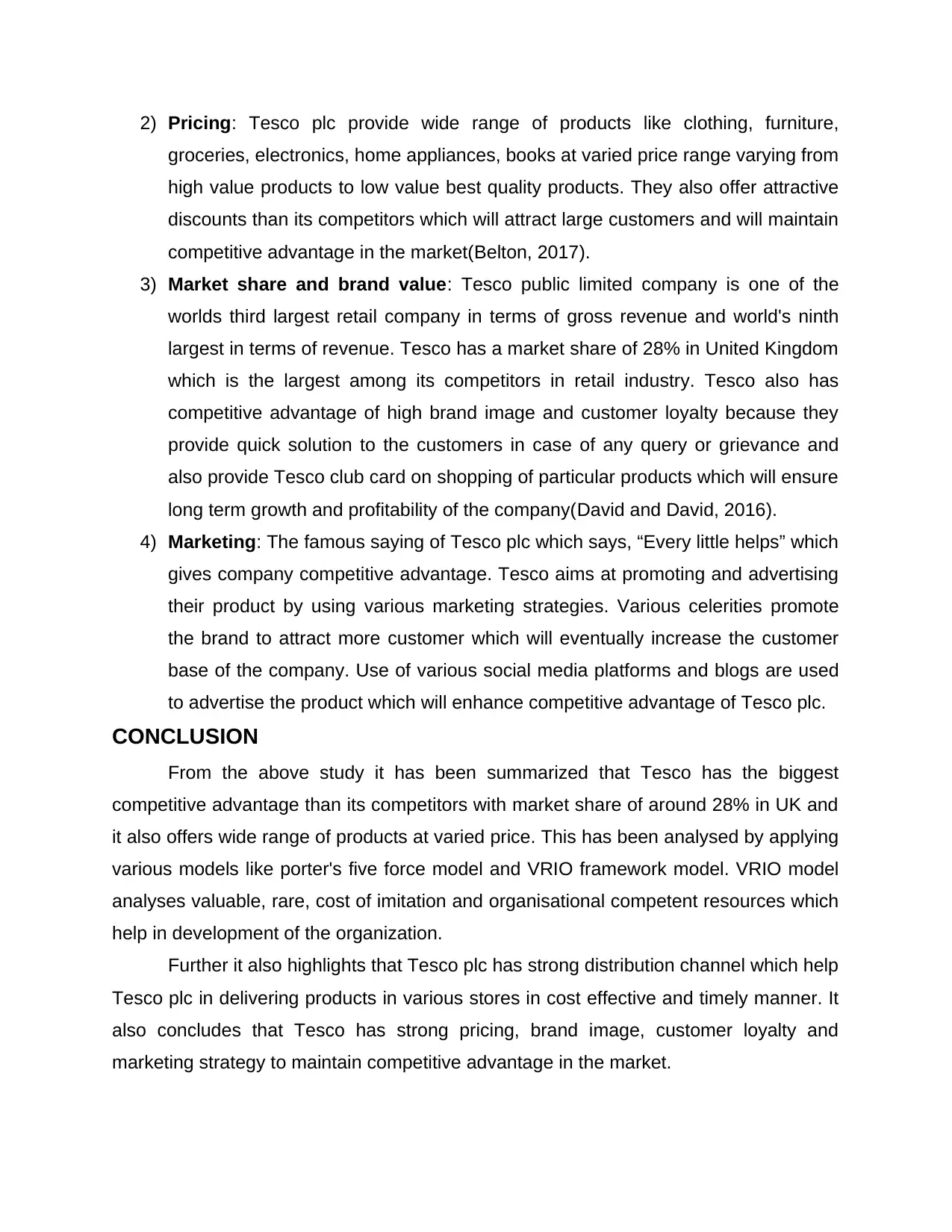
2) Pricing: Tesco plc provide wide range of products like clothing, furniture,
groceries, electronics, home appliances, books at varied price range varying from
high value products to low value best quality products. They also offer attractive
discounts than its competitors which will attract large customers and will maintain
competitive advantage in the market(Belton, 2017).
3) Market share and brand value: Tesco public limited company is one of the
worlds third largest retail company in terms of gross revenue and world's ninth
largest in terms of revenue. Tesco has a market share of 28% in United Kingdom
which is the largest among its competitors in retail industry. Tesco also has
competitive advantage of high brand image and customer loyalty because they
provide quick solution to the customers in case of any query or grievance and
also provide Tesco club card on shopping of particular products which will ensure
long term growth and profitability of the company(David and David, 2016).
4) Marketing: The famous saying of Tesco plc which says, “Every little helps” which
gives company competitive advantage. Tesco aims at promoting and advertising
their product by using various marketing strategies. Various celerities promote
the brand to attract more customer which will eventually increase the customer
base of the company. Use of various social media platforms and blogs are used
to advertise the product which will enhance competitive advantage of Tesco plc.
CONCLUSION
From the above study it has been summarized that Tesco has the biggest
competitive advantage than its competitors with market share of around 28% in UK and
it also offers wide range of products at varied price. This has been analysed by applying
various models like porter's five force model and VRIO framework model. VRIO model
analyses valuable, rare, cost of imitation and organisational competent resources which
help in development of the organization.
Further it also highlights that Tesco plc has strong distribution channel which help
Tesco plc in delivering products in various stores in cost effective and timely manner. It
also concludes that Tesco has strong pricing, brand image, customer loyalty and
marketing strategy to maintain competitive advantage in the market.
groceries, electronics, home appliances, books at varied price range varying from
high value products to low value best quality products. They also offer attractive
discounts than its competitors which will attract large customers and will maintain
competitive advantage in the market(Belton, 2017).
3) Market share and brand value: Tesco public limited company is one of the
worlds third largest retail company in terms of gross revenue and world's ninth
largest in terms of revenue. Tesco has a market share of 28% in United Kingdom
which is the largest among its competitors in retail industry. Tesco also has
competitive advantage of high brand image and customer loyalty because they
provide quick solution to the customers in case of any query or grievance and
also provide Tesco club card on shopping of particular products which will ensure
long term growth and profitability of the company(David and David, 2016).
4) Marketing: The famous saying of Tesco plc which says, “Every little helps” which
gives company competitive advantage. Tesco aims at promoting and advertising
their product by using various marketing strategies. Various celerities promote
the brand to attract more customer which will eventually increase the customer
base of the company. Use of various social media platforms and blogs are used
to advertise the product which will enhance competitive advantage of Tesco plc.
CONCLUSION
From the above study it has been summarized that Tesco has the biggest
competitive advantage than its competitors with market share of around 28% in UK and
it also offers wide range of products at varied price. This has been analysed by applying
various models like porter's five force model and VRIO framework model. VRIO model
analyses valuable, rare, cost of imitation and organisational competent resources which
help in development of the organization.
Further it also highlights that Tesco plc has strong distribution channel which help
Tesco plc in delivering products in various stores in cost effective and timely manner. It
also concludes that Tesco has strong pricing, brand image, customer loyalty and
marketing strategy to maintain competitive advantage in the market.
⊘ This is a preview!⊘
Do you want full access?
Subscribe today to unlock all pages.

Trusted by 1+ million students worldwide
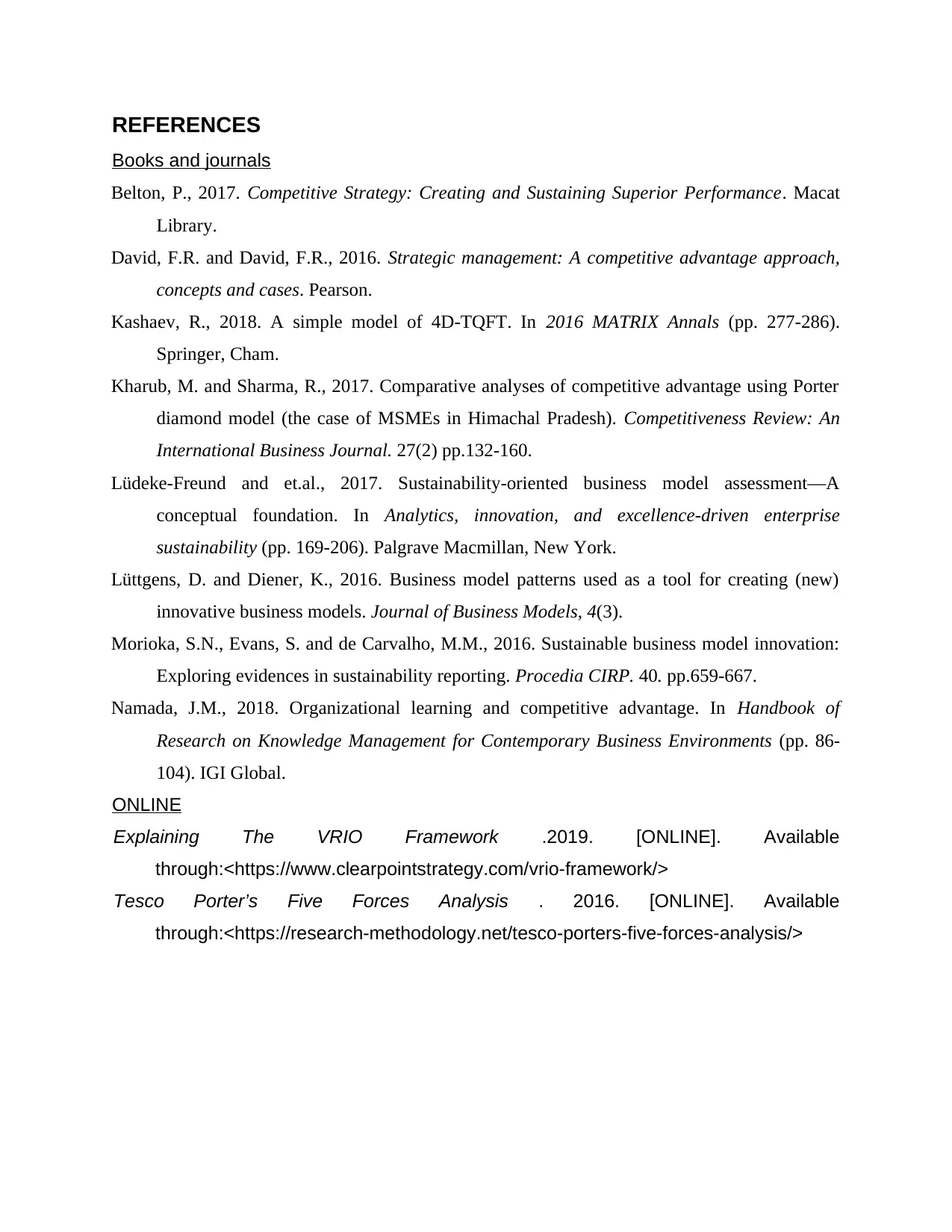
REFERENCES
Books and journals
Belton, P., 2017. Competitive Strategy: Creating and Sustaining Superior Performance. Macat
Library.
David, F.R. and David, F.R., 2016. Strategic management: A competitive advantage approach,
concepts and cases. Pearson.
Kashaev, R., 2018. A simple model of 4D-TQFT. In 2016 MATRIX Annals (pp. 277-286).
Springer, Cham.
Kharub, M. and Sharma, R., 2017. Comparative analyses of competitive advantage using Porter
diamond model (the case of MSMEs in Himachal Pradesh). Competitiveness Review: An
International Business Journal. 27(2) pp.132-160.
Lüdeke-Freund and et.al., 2017. Sustainability-oriented business model assessment—A
conceptual foundation. In Analytics, innovation, and excellence-driven enterprise
sustainability (pp. 169-206). Palgrave Macmillan, New York.
Lüttgens, D. and Diener, K., 2016. Business model patterns used as a tool for creating (new)
innovative business models. Journal of Business Models, 4(3).
Morioka, S.N., Evans, S. and de Carvalho, M.M., 2016. Sustainable business model innovation:
Exploring evidences in sustainability reporting. Procedia CIRP. 40. pp.659-667.
Namada, J.M., 2018. Organizational learning and competitive advantage. In Handbook of
Research on Knowledge Management for Contemporary Business Environments (pp. 86-
104). IGI Global.
ONLINE
Explaining The VRIO Framework .2019. [ONLINE]. Available
through:<https://www.clearpointstrategy.com/vrio-framework/>
Tesco Porter’s Five Forces Analysis . 2016. [ONLINE]. Available
through:<https://research-methodology.net/tesco-porters-five-forces-analysis/>
Books and journals
Belton, P., 2017. Competitive Strategy: Creating and Sustaining Superior Performance. Macat
Library.
David, F.R. and David, F.R., 2016. Strategic management: A competitive advantage approach,
concepts and cases. Pearson.
Kashaev, R., 2018. A simple model of 4D-TQFT. In 2016 MATRIX Annals (pp. 277-286).
Springer, Cham.
Kharub, M. and Sharma, R., 2017. Comparative analyses of competitive advantage using Porter
diamond model (the case of MSMEs in Himachal Pradesh). Competitiveness Review: An
International Business Journal. 27(2) pp.132-160.
Lüdeke-Freund and et.al., 2017. Sustainability-oriented business model assessment—A
conceptual foundation. In Analytics, innovation, and excellence-driven enterprise
sustainability (pp. 169-206). Palgrave Macmillan, New York.
Lüttgens, D. and Diener, K., 2016. Business model patterns used as a tool for creating (new)
innovative business models. Journal of Business Models, 4(3).
Morioka, S.N., Evans, S. and de Carvalho, M.M., 2016. Sustainable business model innovation:
Exploring evidences in sustainability reporting. Procedia CIRP. 40. pp.659-667.
Namada, J.M., 2018. Organizational learning and competitive advantage. In Handbook of
Research on Knowledge Management for Contemporary Business Environments (pp. 86-
104). IGI Global.
ONLINE
Explaining The VRIO Framework .2019. [ONLINE]. Available
through:<https://www.clearpointstrategy.com/vrio-framework/>
Tesco Porter’s Five Forces Analysis . 2016. [ONLINE]. Available
through:<https://research-methodology.net/tesco-porters-five-forces-analysis/>
1 out of 10
Related Documents
Your All-in-One AI-Powered Toolkit for Academic Success.
+13062052269
info@desklib.com
Available 24*7 on WhatsApp / Email
![[object Object]](/_next/static/media/star-bottom.7253800d.svg)
Unlock your academic potential
Copyright © 2020–2025 A2Z Services. All Rights Reserved. Developed and managed by ZUCOL.



